One of the best resources of an amateur astronomer is an astronomy club -- if you are lucky enough to live close to one. But not all are created equal.
The Atlanta Astronomy Club has been a bit of a disappointment -- I showed up for their meeting in September, only to find the building locked. I found out later you have to arrive early, before the security guard locks the doors. I showed up in October, only to find out later they had no meeting that month. The club is large enough to become impersonal - but I highly recommend them because they are large enough to afford to bring in wonderful speakers and programs. So stick with them for a while!! They maintain a great dark site and astronomy village. They have several telescopes and observing programs.
The Northwest Georgia Astronomy Association is a very hospitable group. They are an informal group where there are no dues and anyone with an interest in any aspect of astronomy is welcome and 'belongs'.
The Southern Cross in south Miami is a great group and has a great outreach into the community by having solar viewing set up on Sundays at the Miami Zoo. Their star party in the Keys is one of the best.
The South Florida Amateur Astronomy Association has a great observatory (Fox) and is very welcoming to visitors, guests and new members.
When I started in astronomy, I had no mentors to help me learn how to use a telescope or find the Ring Nebula. My first contact with other astronomers was at a viewing area for a solar eclipse in 1971. It was sponsored by the Astronomical League, which is a wonderful resource for those of us who are "at large" members who are not close enough to a good club.
If you can't join a local club, the Astronomical League is well worth your time.
2006-10-28
2006-10-17
Uranus In Motion and Comet Swan's Appearance
Using the remote telescope at www.Slooh.com, I have been tracking Uranus. I entered the same coordinates for several consecutive nights so the star field does not change. I then drew some simple lines among the stars to show the consistent patterns. Here are two images, with the one I took today inserted in the one I took 20 hours earlier.

I'm still spending a lot of time looking for and photographing Arp Peculiar Galaxies -- but maybe the Divas have convinced me to spend a little more time looking at asteroids.
I haven't seen Comet Swan from my backyard yet, but I was able to see it this evening with Slooh -- which is a remote controlled telescope off the coast of Africa in the Canary Islands. The image below was taken on 2006 October 17 at 1932 utc. That is another great thing about www.Slooh.com -- at 1932 utc it was still mid to late afternoon where I am.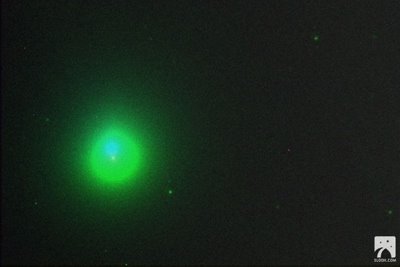

I'm still spending a lot of time looking for and photographing Arp Peculiar Galaxies -- but maybe the Divas have convinced me to spend a little more time looking at asteroids.
I haven't seen Comet Swan from my backyard yet, but I was able to see it this evening with Slooh -- which is a remote controlled telescope off the coast of Africa in the Canary Islands. The image below was taken on 2006 October 17 at 1932 utc. That is another great thing about www.Slooh.com -- at 1932 utc it was still mid to late afternoon where I am.

2006-10-16
Asteroid 7 Iris -- Surprisingly Bright
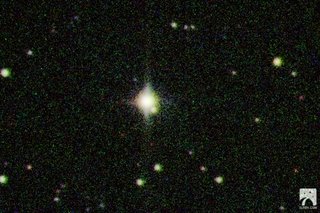 I logged onto Slooh.com and enjoyed a great radio show by the "Divas" - Marleen and Tavi. While they talked, the telescope zoomed in on Iris.
I logged onto Slooh.com and enjoyed a great radio show by the "Divas" - Marleen and Tavi. While they talked, the telescope zoomed in on Iris.I'm not a big observer of asteroids. They usually look like nothing more than a dim star. But not with Iris. Right now we are fairly close to Iris, so it was surprisingly bright -- well, surprisingly to me!
2006-10-14
Comet Faye Moves On
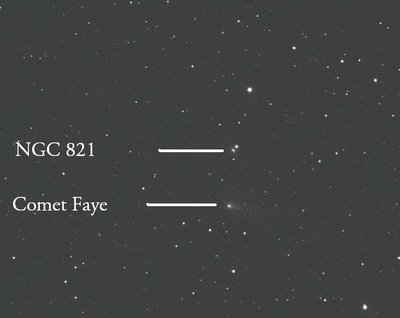
Comet Faye passed by the field of view with a galaxy over a period of a few days in October.
These two photos show the motion, relative to the somewhat indistinctive galaxy NGC 821. This photo also shows how a comet hunter can easily mistake a small fuzzy object with a galaxy or nebula.
The first photo was taken on October 11, 2006, at 2130 UTC, using 14-inch diameter Schmidt Cassegrain Telescope, with a 3910mm focal length, and a magnification of 470. The photo does not show the galaxy very well, but in larger images it does show up as a fuzz-ball that is somewhat smaller in appearance than the comet.
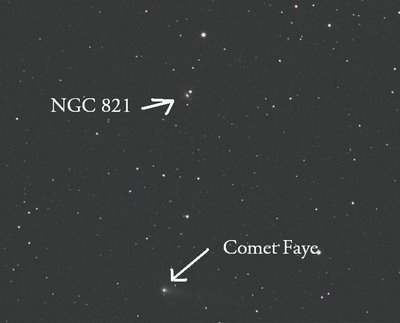 The second image was taken with the same telescope, set on the exact same coordinates (Right Ascension 2 hours, 8 minutes and Declination 10 degrees 47' 27"). The second image was taken on October 13th at 2332 UTC.
The second image was taken with the same telescope, set on the exact same coordinates (Right Ascension 2 hours, 8 minutes and Declination 10 degrees 47' 27"). The second image was taken on October 13th at 2332 UTC.Seeing was at 4.5 for both nights (4 out of 5). Examining the stars in the background, the conditions seem to be identical.
2006-10-10
Neptune's Motion Through The Skies
Below are two photos I shot through the remote controlled telescope in the Canary Islands -- see www.slooh.com to check out how to use this yourself.
Seeing was poor on the first night (1.7 out of 5), but exellent on the second night. I have drawn a line in a pattern of stars to show the movement of Neptune from October 4th through October 9th.
Double click the image for a larger view of the photos.

Seeing was poor on the first night (1.7 out of 5), but exellent on the second night. I have drawn a line in a pattern of stars to show the movement of Neptune from October 4th through October 9th.
Double click the image for a larger view of the photos.

2006-10-07
Comet c/2006 T1 (Levy)
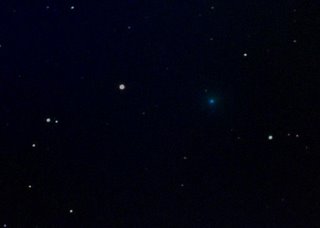 David Levy has discovered a new comet -- I believet his makes 22 discoveries for him!
David Levy has discovered a new comet -- I believet his makes 22 discoveries for him!I observed the comet last night, and even with a full moon I was able to spot it and take this 5 minute exposure photo. The equipment used was a 14 inch Schmidt Cassegrain.
You can barely see it -- but it is there. It shows up as a bluish haze. I could not see a distinct tail at all.
The positions for the comet for the next few evenings will be:
2006 10 07 09 55.04 +12 56.6This ephemeris comes from http://cfa-www.harvard.edu/iau/Ephemerides/Comets/2006T1.html
2006 10 12 10 13.68 +09 39.4
2006 10 17 10 31.47 +06 23.1
2006 10 22 10 48.44 +03 10.2
2006 10 27 11 04.65 +00 02.5
2006 11 01 11 20.16 -02 58.4
2006 11 06 11 34.99 -05 51.6
2006 11 11 11 49.19 -08 36.6
2006 11 16 12 02.79 -11 13.0
2006 11 21 12 15.80 -13 40.8
2006 11 26 12 28.23 -15 59.9
2006 12 01 12 40.09 -18 10.7
Subscribe to:
Posts (Atom)